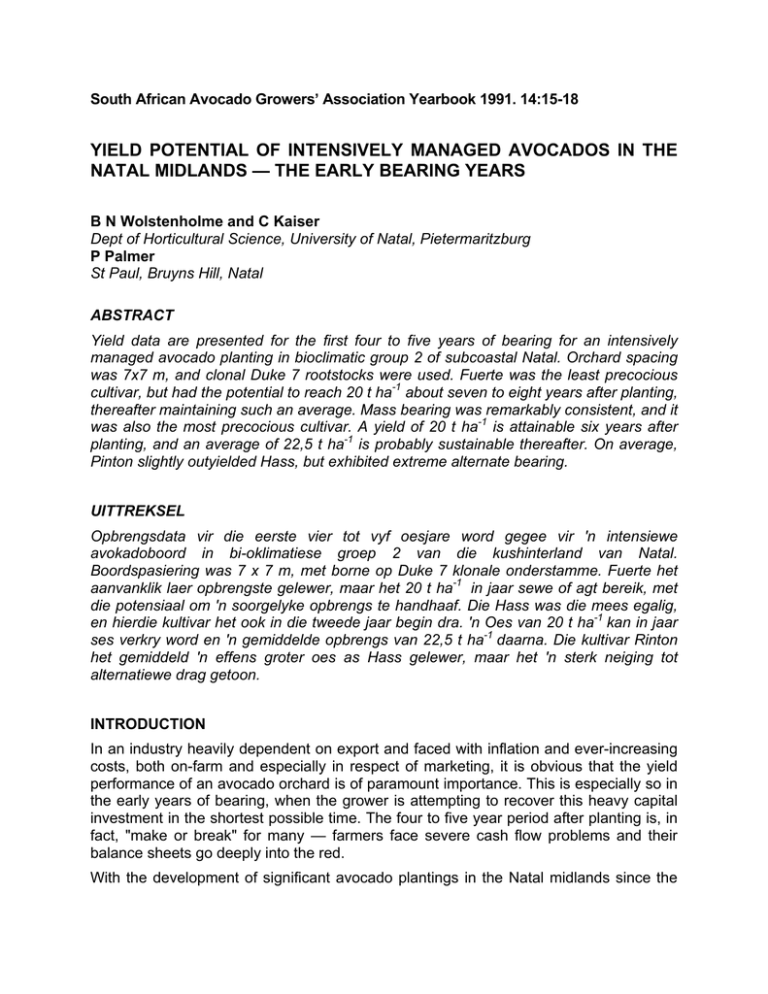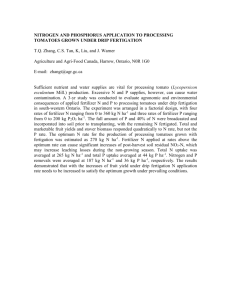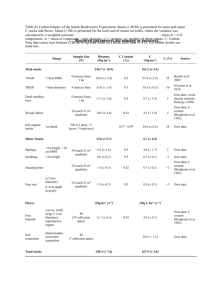YIELD POTENTIAL OF INTENSIVELY MANAGED AVOCADOS IN THE
advertisement

South African Avocado Growers’ Association Yearbook 1991. 14:15-18 YIELD POTENTIAL OF INTENSIVELY MANAGED AVOCADOS IN THE NATAL MIDLANDS — THE EARLY BEARING YEARS B N Wolstenholme and C Kaiser Dept of Horticultural Science, University of Natal, Pietermaritzburg P Palmer St Paul, Bruyns Hill, Natal ABSTRACT Yield data are presented for the first four to five years of bearing for an intensively managed avocado planting in bioclimatic group 2 of subcoastal Natal. Orchard spacing was 7x7 m, and clonal Duke 7 rootstocks were used. Fuerte was the least precocious cultivar, but had the potential to reach 20 t ha-1 about seven to eight years after planting, thereafter maintaining such an average. Mass bearing was remarkably consistent, and it was also the most precocious cultivar. A yield of 20 t ha-1 is attainable six years after planting, and an average of 22,5 t ha-1 is probably sustainable thereafter. On average, Pinton slightly outyielded Hass, but exhibited extreme alternate bearing. UITTREKSEL Opbrengsdata vir die eerste vier tot vyf oesjare word gegee vir 'n intensiewe avokadoboord in bi-oklimatiese groep 2 van die kushinterland van Natal. Boordspasiering was 7 x 7 m, met borne op Duke 7 klonale onderstamme. Fuerte het aanvanklik laer opbrengste gelewer, maar het 20 t ha-1 in jaar sewe of agt bereik, met die potensiaal om 'n soorgelyke opbrengs te handhaaf. Die Hass was die mees egalig, en hierdie kultivar het ook in die tweede jaar begin dra. 'n Oes van 20 t ha-1 kan in jaar ses verkry word en 'n gemiddelde opbrengs van 22,5 t ha-1 daarna. Die kultivar Rinton het gemiddeld 'n effens groter oes as Hass gelewer, maar het 'n sterk neiging tot alternatiewe drag getoon. INTRODUCTION In an industry heavily dependent on export and faced with inflation and ever-increasing costs, both on-farm and especially in respect of marketing, it is obvious that the yield performance of an avocado orchard is of paramount importance. This is especially so in the early years of bearing, when the grower is attempting to recover this heavy capital investment in the shortest possible time. The four to five year period after planting is, in fact, "make or break" for many — farmers face severe cash flow problems and their balance sheets go deeply into the red. With the development of significant avocado plantings in the Natal midlands since the late 1970's, the question of yield potential was often raised. Would average yields be lower than in the climatically more favoured Tzaneen and Burgershall areas — especially in the midlands mistbelt zone (bioclimatic group 3), with its significantly cooler climate? Would later fruit maturity, with its economic advantage on the local market, adversely reduce overall yields? These questions are being actively researched at present. An opportunity to investigate yield potential of three cultivars in the somewhat warmer bioclimatic group 2 — the coastal interior, was provided by one of the authors (PP), who was persuaded to keep individual tree records in an intensively managed planting at Bruyns Hill. This paper summarises the results to date, for trees up to eight years of age. AVERAGE AVOCADO YIELDS The yield potential of avocados has been summarised by Wolstenholme (1986,1987, 1988). Ignoring state and national averages, which for many reasons are very low, eg less than 5 t ha-1 for South Africa (Kotzé, 1986) — what can be considered a good commercial yield? This is affected by cultivar, rootstock, soil and climate, management philosophy and intensity, and of course tree age. It is also important to stress that only average yields should be used, based on data of at least four or five years from a reasonably large area. Furthermore, because number of trees per ha varies widely, yield per tree is meaningless unless related to trees per ha. The most useful yield criterion by far is average yield in tonnes per hectare — growers and researchers should become attuned to this concept. On this basis, good California growers achieve between about 7 and 11 t ha-1 for Fuerte and 8 to 13 t ha-1 for Hass. A conservative yield average target for South African and Australian growers is about 12 t ha-1. Toerien et al (1984) used a mature orchard average yield of 21,61 ha-1 for intensively managed orchards in the Tzaneen area, 18 t ha-1 for orchards with "intermediate" management, and a maximum yield of 11 t ha-1 (in year 10) for "extensively" managed orchards. Today, with ultra-high density plantings (up to 800 trees ha-1) and growth control with paclobutrazol, significantly higher target yields are in prospect (Köhne & Kremer-Köhne, 1990) and furthermore, will be achieved far earlier in the life of the orchard. Toerien (1989) again discussed the economics of avocado growing, and noted that industry income is strongly affected by yield and fruit quality. Earnings at the industry average yield of 5 t ha-1 (1987) were R46 million with 55% export, but would have been R69 million at 7,51 ha-1 and R138 million at 15 t ha-1 average. For 85% export, equivalent figures were R67 m, R101 m and R202 million. Since tree age is such an important criterion in the yield potential of a recently planted orchard, it is instructive to note the production figures used by Toerien (1989) for extensive and intensive orchards. In both cases, yield was zero for years one and two. In year three, the extensive orchard yielded 0,8 t ha-1, and the intensive orchard 2,9 t ha-1. The respective figures for year four were 1,6 and 7,1 t ha-1; for year five 4,0 and 11,31 ha-1; and year six 6,0 and 15,4t ha-1. In year seven, the extensive orchard could be expected to yield 7,5 t ha-1, but the intensive orchard will have reached its peak average of 19,6 t ha-1, — an average that can subsequently be maintained by intensive management. The extensive orchard peaked at 11 t ha-1, and only in year ten, with yields subsequently declining. These figures can then serve as a realistic target for comparison with Natal orchards. MATERIALS AND METHODS The farm St Paul, is situated in bioclimatic group 2 in the Bruyns Hill area, at 30°07'E and 29°05'S. The mean elevation is 980 m, and rainfall averages somewhat less than 900 mm pa. The soil is Inanda form, Indanda series, with ca 35% clay, derived from Table Mountain sandstone, with excellent physical properties (humic A on red apedal B) and great depth. Eleven orchards were used in this study. Details of planting date (1982 to 1984), cultivar, and numbers of trees planted per orchard, and numbers of trees remaining in 1990 after tree thinning, are given in Table 1. All trees are on clonal Duke 7 rootstock; were initially planted at a spacing of 7 x 7 m (200 trees ha-1) and are irrigated by microjets based on tensiometer readings. Fertilisation is based on soil and leaf analysis. Management is good and can be classed as "intensive", but not "ultra-intensive". Tree thinning is carried out only when adjacent canopies start to intermingle, and to date has been limited to Fuerte. Yield records have been kept for individual trees, and are based on the number of lugs (17,5 kg of fruit per lug) per tree. This is therefore only an estimate of yield per tree, but packhouse records also provided yield data for particular orchards. In spite of all reasonable precautions, including electric fencing and limited access to orchards through a copper sulphate bath, the first signs of infection with Phytophthora cinnamomi were apparent within four years of planting. Due to good soil properties and remedial measures, however, the extent and effects of root rot have been limited. In the first four years in particular, tree growth was extremely vigorous. This was attributed to high nitrogen mineralisation potential from the high organic matter content of the A horizon, and a management philosophy that initially encouraged vegetative growth. RESULTS AND DISCUSSION Yields in t ha-1 for individual orchards and years, from 1986 to 1990 are shown in Figures 1 to 5. Weighted average yield (adjusted for tree number) in t ha-1 for the first four to six years of bearing are shown in Figure 6, and cumulative yields in Figure 7, It is clear from Figure 6 that Hass averaged somewhat over 15 t ha-1 for the first five or six bearing years, Fuerte nearly 13 t ha-1 for the same period, and Rinton about 16 t ha-1 for the first four years of bearing. Cumulative yields of comparable orchards were 80 t ha-1 for Hass (five years), 62 t ha-1 for Fuerte (five years), and 69 t ha-1 for Rinton (four years) (Figure 7), Annual variability in average yield for each cultivar is shown in Figure 8. It is evident that Hass was the most consistent bearer, with average yields generally increasing with tree age but never dropping below 10 t ha-1. In contrast, Fuerte yields showed fairly marked alternate bearing, with 1988 being a particularly low "off" season. Rinton showed even more pronounced alternation. The first significant crop in year three (after planting) was 19 t ha-1. This declined to just over 4 t ha-1 in year four, to 39 t ha-1 in year five, followed by 7 t ha-1 in year six. The very heavy first crop appeared to impose this marked bearing alternation on Rinton from the first year of bearing, with crop overloading presumably already exhausting carbohydrdate reserves in the third season. Average yields according to tree age are given in Figure 9. Hass was the most precocious cultivar, with bearing starting in the second season, and reaching 10 t ha-1 by year three. Rinton (purchased as Pinkerton, which has a reputation for extreme precocity), only started bearing in year three, but this first crop averaged 19 t ha-1 from 201 trees! Fuerte also started bearing in the third year, these trees then having reached a considerable size due to extreme vigour. This initial bearing was mostly on shorter, interior shoots. When individual seasons are compared, the most obvious conclusions are that there was a remarkable "smoothing out" effect in terms of total orchard yield, i.e. a bad season for a particular cultivar (either Fuerte or Rinton) tended to be compensated for by a good season for another cultivar, usually Hass. The worst season for Hass was 1987, when Fuerte and Rinton performed well. A very poor season for both Fuerte and Rinton was 1988, but most Hass orchards yielded well (the exception being orchard 9). Hass and to a lesser extent Fuerte had good average yields in 1990, when Rinton was in an "off" season, although this was also an "off" year for Fuerte. It is noticeable, however, that Fuerte and Rinton alternated together according to tree age (Figure 9). This implies that climate has a strong influence on alternation in cultivars prone to alternate bearing, and favourable temperatures at fruit-set (especially in B flowering type cultivars such as Fuerte) can result in heavy cropping which can deplete energy reserves for the subsequent season's cropping. Hass, an A-type flowerer, tended to be out of phase with Fuerte and Rinton on a seasonal yield basis. Figure 10 is an attempt to indicate yield potential under the spacing, management and environmental conditions relevant to the site, based on "smoothed" yield curves; up to year eight when orchards can be considered to be approaching maximum sustainable average yields. These yield curves can be used for planning purposes for well-managed orchards in bioclimatic group 2 (Phillips, 1973) in the Natal midlands. The data suggest that average yields of about 20 t ha-1 can be reached in year seven or eight for Fuerte, but that this cultivar is at a distinct disadvantage in earlier years, and requires about five years to reach 101 ha-1. In contrast, both Hass and Rinton can reach 10 t ha-1 in the third year, and 20 t ha-1 in the sixth and fifth years respectively. Rinton appears to have a slightly higher average yield potential than Hass, viz about 25 t ha-1 as opposed to 22,5 t ha-1 but its very marked alternation is a cause for concern. It was found, using the data for Hass orchard no 11, that yield and stem circumference were related, the regression coefficient being r = 0,257 at the 0,76% level of significance. The question of the fitted line was: y = 0,04 x 4,3 where y = expected yield in lugs (17,5 kg) per tree per year, and x = stem circumference in cm. Finally, export percentages will influence the overall profitability of a particular cultivar. Actual figures for five seasons are given in Figure 10. It is evident that Rinton was at a disadvantage to the other cultivars, higher cull rates being due to apparent extreme susceptibility to anthracnose, and to a greater percentage of blemished fruit. Nevertheless, gross returns to the farm after deducting marketing costs showed very little difference between Rinton (average of R12 350 per ha) and Hass (R12 150) although the former was only for four years as opposed to five for Hass. The five year average for Fuerte was R9 740. It should be noted that on-farm costs have not been deducted form these figures. CONCLUSIONS Yield records for an intensively managed avocado planting, comprising 11 orchards of (initially) some 1 900 trees of three cultivars, are presented for the first four (Rinton) and five (Fuerte, Hass) years of bearing. Hass was the most precocious and consistent bearer, averaging over 15 t ha-1 and reaching an average of 20 t ha-1 by the sixth year. Thereafter, an average yield of about 22,5 t ha-1 appears to be sustainable. At a spacing of 7 x 7 m (200 trees per ha), very little orchard thinning was necessary before the seventh or eight year. Although bearing started in the third rather than the second year, Rinton outyielded Hass by a small margin on average, and may have the potential to average 25 t ha-1 under the conditions experienced in the Bruyns Hill area. Possibly aggravated by the very heavy first crop however, its alternate bearing pattern was extreme, and export percentages were lower than for the other cultivars. Fuerte was the least precocious of the three cultivars, and required seven or eight years to reach 201 ha-1, which would appear to be an attainable mature orchard target yield in the relatively warm bioclimatic group 2 of subcoastal Natal. However, orchard thinning at a 7 x 7 m espacement was necessary from year five or six. Due to its B flowering pattern however, yield expectations (Whiley & Winston, 1987) would be lower in the cooler, more elevated localities of bioclimatic group 3 (the midlands mistbelt). Alternate bearing was evident, but less pronounced than in Rinton. It is believed that Figure 10 can serve as a realistic estimate of yield potential for intensively managed orchards with good resources under similar climatic conditions. Good Phytophthora control and timely tree thinning are implied. These yields are higher than initially envisaged, probably due to the relative lateness of flowering and fruit-set, thereby partly nullifying the cool winter. Ultra-intensive spacings (400 to 800 trees per ha) should merely increase initial yields, so that the target yield of 20 to 25 t ha-1 is reached even earlier. Lastly, as individual tree records are available, an excellent opportunity exists to select high-yielding trees for propagation purposes. In spite of clonal rootstocks, certain pooryielding as well as high yielding trees have been identified. Such records have proven to be useful from an orchard management viewpoint. REFERENCES KÖHNE, J S & KREMER-KÖHNE, S, 1990. Results of a high density avocado planting. S A Avocado Growers' Assoc Yrb 13, 31 - 34. KOTZÉ, J M, 1986. Research in perspective. S A Avocado Growers' Assoc Yrb 9, 5 - 6. PHILLIPS, J, 1973. The agricultural and related development of the Tugela basin and its influent surrounds. Natal Town & Regional Planning Report, Vol 19. TOERIEN, J C, 1989. Aspects of the economy of avocado production in South Africa. S A Avocado Growers' Assoc Yrb 12, 7 - 9. TOERIEN, J C, MEYER, N & MILNE, D L, 1984. The economics of avocado production in the Tzaneen area. S A Avocado Growers' Assoc Yrb 7, 69 - 71. WHILEY, A W & WINSTON, E C, 1987. Effect of temperature at flowering on varietal productivity in some avocado growing areas in Australia. S A Avocado Growers' Assoc Yrb 10, 45 - 47. WOLSTENHOLME, B N, 1986. Energy costs of fruiting as a yield-limiting factor, with special reference to avocado. Acta Hort 175, 121 - 126. WOLSTENHOLME, B N, 1987. Theoretical and applied aspects of avocado yield as affected by energy budgets and carbon partitioning. S A Avocado Growers' Assoc Yrb 10, 59 - 61. WOLSTENHOLME, B N, 1988. An overview of avocado technology towards 2000. Aoc Austr Avocado Bicentenn Conf, Calounda, pp 4 - 13.

